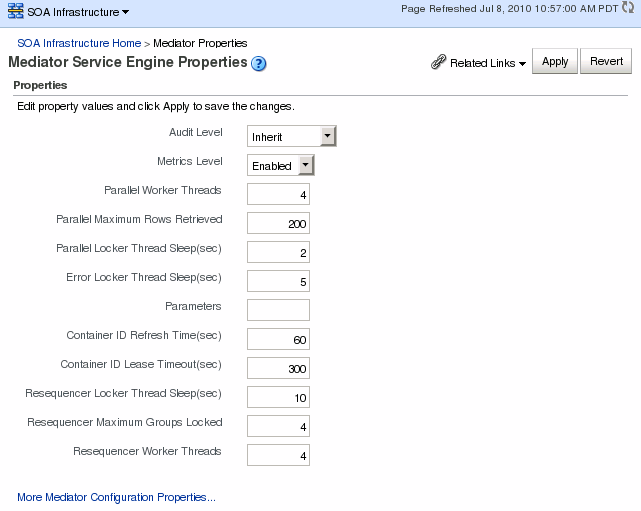| Oracle® Fusion Middleware Administrator's Guide for Oracle SOA Suite and Oracle Business Process Management Suite 11g Release 1 (11.1.1.5.0) Part Number E10226-08 |
|
|
View PDF |
| Oracle® Fusion Middleware Administrator's Guide for Oracle SOA Suite and Oracle Business Process Management Suite 11g Release 1 (11.1.1.5.0) Part Number E10226-08 |
|
|
View PDF |
This chapter describes how to configure Oracle Mediator service components and service engines.
This chapter includes the following topics:
You can configure Oracle Mediator service engine properties, which are used by the Oracle Mediator service engine during processing of Oracle Mediator service components.
To configure Oracle Mediator service engine properties:
Access this page through one of the following options:
| From the SOA Infrastructure Menu... | From the SOA Folder in the Navigator... |
|---|---|
|
|
The Mediator Service Engine Properties page displays the following properties:

Make changes to the service engine properties that are appropriate to your environment.
| Property | Description |
|---|---|
| Audit Level | You can configure the Oracle Mediator-specific audit levels. The value of this property overrides the value of the global SOA Infrastructure audit level property. The possible values of this property are:
The default value of this flag is Inherit. Notes:
|
| Metrics Level | You can set the Oracle Mediator-specific property for configuring the Dynamic Monitoring Service (DMS) metrics level. DMS metrics are used to measure the performance of application components. The possible values of this property are:
|
| Parallel Worker Threads | Specifies the number of parallel dispatchers for message processing. Increase this parameter to increase the number of outbound threads for parallel processing. |
| Parallel Maximum Rows Retrieved | Specifies the number of rows retrieved per iteration for parallel processing. You can set the value of this parameter to 50 to 100 times the Parallel Worker Threads property, depending on the memory consumption limit.
Note: A large value for this property can result in memory exhaustion. |
| Parallel Locker Thread Sleep (sec) | Specifies the idle time between two successive iterations for retrieving rows, when there is no message for parallel processing. The time is measured in seconds. |
| Error Locker Thread Sleep (sec) | You can configure the error/retry infrastructure by setting this property. This property specifies the idle time between two successive iterations for retrieving errored out messages, when there is no errored out message from parallel processing. The time is measured in seconds. |
| Parameters | Specify custom configuration properties. For an example, see Section 14.2, "Configuring Resequenced Messages." |
| Container ID Refresh Time (sec)
Container ID Lease Timeout (sec) |
The heartbeat infrastructure is a part of the Oracle Mediator service engine and detects the absence of an Oracle Mediator service engine instance due to failure or shutdown of a node. The heartbeat infrastructure creates a unique identifier for each instance of the Oracle Mediator service engine and performs the necessary housekeeping tasks, if an Oracle Mediator service engine fails. The heartbeat infrastructure consists of a heartbeat thread. The heartbeat thread periodically updates the time stamp associated with each Oracle Mediator service engine's unique identifier. By updating the time stamp associated with it, an Oracle Mediator service engine announces its presence to the other Oracle Mediator service engines. The heartbeat thread also checks if there are unique identifiers that have not been updated for a particular period of time. You can configure the heartbeat framework by setting the following parameters:
By configuring these parameters, you can specify the period used by the heartbeat thread to detect the failure of an Oracle Mediator service engine. |
| Resequencer Locker Thread Sleep (sec) | Specifies the sleep time in seconds for a deferred locker when there is no message in the database. |
| Resequencer Maximum Groups Locked | Specifies the maximum number of groups locked. |
| Resequencer Worker Threads | Specifies the number of resequencers. |
If you want to configure advanced Oracle Mediator properties in the System MBean Browser, click More Mediator Configuration Properties.
You can also access Oracle Mediator properties in the System MBean Browser through the navigator.
To access System MBean Browser properties:
From the SOA Infrastructure menu, select Administration > System MBean Browser
The System MBean Browser page is displayed.
Expand the node oracle.as.soainfra.config in the left pane (below the page title).
The Server:soa_server1 node is displayed.
Expand the Server:soa_server1 node.
The MediatorConfig node is displayed.
Expand the MediatorConfig node.
The mediator MBean is displayed.
Click the mediator MBean.
The properties of the MBean are displayed on the right pane.
Change the value of the properties and click Apply.
For Oracle Mediator service components to resequence messages, you must configure the following:
The worker thread count
The maximum number of groups that can be locked by a thread
The sleep interval
If the Oracle Mediator service component is configured to use best effort resequencing and the messages to process in each batch are based on a time window rather than a maximum number of rows, you can also configure the buffer window.
To configure resequenced messages:
Access the Oracle Mediator Service Engine Properties page or the System MBean Browser using one of the methods described in Section 14.1, "Configuring Oracle Mediator Service Engine Properties."
Enter a value for the following Oracle Mediator properties:
Resequencer Worker Threads: The number of threads used by resequencers.
Resequencer Maximum Groups Locked: The maximum number of group rows retrieved for each locking cycle.
Resequencer Locker Thread Sleep: The length of time in seconds for the deferred locker to sleep when there are no messages in the database.
To configure the buffer window for the time window in best effort resequencing, enter the following for the Parameters property value:
buffer.window=x
Where x is the percentage of the configured time window to add to the buffer. For example, buffer.window=20 means that 20% of the length of the time window is added as a buffer.
Click Apply.